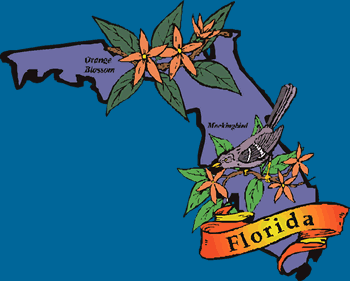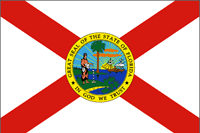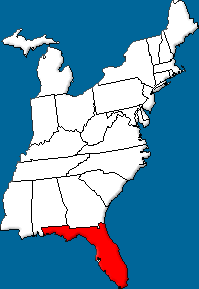 History:
The first European explorer to come to Florida was Spaniard Juan Ponce de Leon in 1513. He first came ashore on the northeast coast of Florida near present-day St. Augustine. He called the area la Florida after Spain's Eastertime celebration Pascua Florida ("feast of the flowers").
By 1521, Ponce de Leon visited Florida again on another voyage and brought with him 200 settlers and 50 horses. Unfortunately, attacks by native people led to the failure of this potential colony. Despite this, Florida had become a desirable place for explorers, missionaries and others looking for treasure.
Another treasure hunter was Hernando de Soto, who was exploring throughout what is now the southeastern portion of the United States. De Soto and his soldiers spent four years looking for the fabled wealth of the native peoples, and spent five months camped in the area that is now Tallahassee, Florida.
Neither de Soto nor any of the other explorers ever found the great treasure they were looking for in Florida, but that didn't stop more of the Spanish conquistadores from sailing in and around the area with their ships laden with gold and silver from conquests in Cuba, Mexico and Central and South America. Knowing this, the area became popular with pirates looking to capture the ships and take the treasure for themselves. Hurricanes and other weather hazards added to the danger for ships in the area.
In 1562, a French explorer Rene Goulaine de Laudonniere established the first non-Spanish colony in the Florida by building Fort Caroline near present-day Jacksonville. This French settlement prompted Spain to increase its efforts to settle Florida under her own flag. In 1565, Pedro Menendez de Aviles established the first permanent European settlement at San Augustin (St. Augustine). He expelled the French and renamed Fort Caroline as San Mateo. For a number of years, the Spanish and the French battled for control of the territory. The Spanish eventually gained the upper hand. By 1600, Spain's power over what is now the southeastern section of the United State was unquestioned. As a result, when English explorers sought to establish colonies in the new world, they chose sites in New England or along the mid-Atlantic coast.
As time went on, however, English and French settlers pushed closer and closer to these Spanish strongholds, and conflict was inevitable. In 1763, the British gained control of Florida in trade for Spanish control over Havana, Cuba as a result of the provisions of the treaty ending the French and Indian War. The British ambitiously split Florida into two colonies, East and West Florida, and began mapping the territory and trying to establish relations with the native people there, whom the British called Seminolies or Seminoles. These people were actually part of the Creek tribe that had settlements throughout the East Coast of America.
However, Spain still set its sights on Florida, and was able to capture the town of Pensacola from the British during the time of the American Revolution. When the Revolution ended, Florida again came under Spanish rule. It was too late, however, and the colony was soon overrun with settlers looking for easy land grants and slaves who were looking for a place outside their masters' authority. Eventually, Spain ceded the territory of Florida to the United States in 1821 under the terms of the Adams-Onis Treaty.
Andrew Jackson, recently a hero of the War of 1812, was sent to the area to establish a U.S. territory, and merged the two Floridas into one with a capitol in Tallahassee. Increased settlement from other U.S. states forced further conflict with the Seminole natives. Many white settlers were in favor of relocating the Seminoles to land west of the Mississippi River, to the area now known as Oklahoma. A series of conflicts, known as the Seminole Wars, were the result. In the end, some of the Indians "migrated," but many escaped into the interior of the state, into the area of the Everglades, and along with escaped African slaves, developed communities of their own.
By the 1840s, Florida had a large enough population to gain statehood, and in 1845, became the 27th state in the U.S. Just prior to statehood, nearly half the population was African American, and following statehood, that proportion remained almost constant. With tension growing throughout the South on the issue of slavery, that issue began to dominate the political affairs of the state. In 1861, Florida joined the rest of the southern states in seceding from the Union and forming the Confederate States of America.
No major battles during the Civil War took place on Florida soil, but the state provided provisions and men to both sides of the conflict. In fact, over 2,000 Floridians, both white and black, joined the fight on the Union side. Ultimately, the South was defeated, and the state was occupied by Federal troops in 1865, where they remained for nearly eleven years. |









